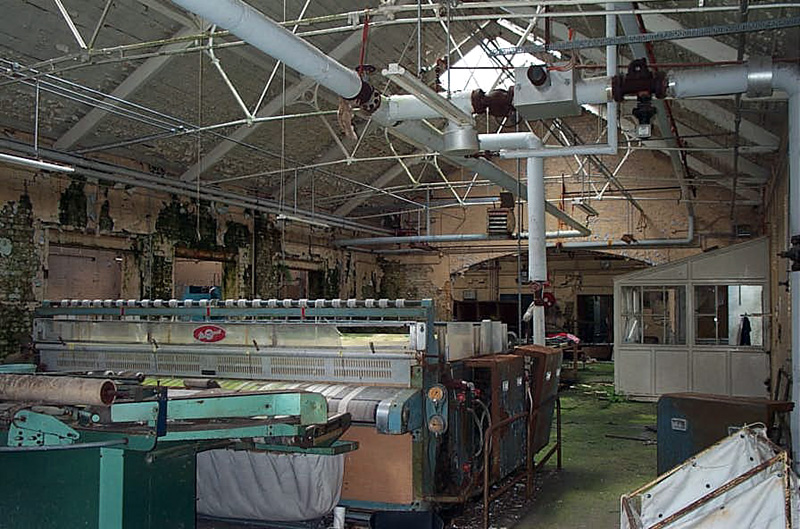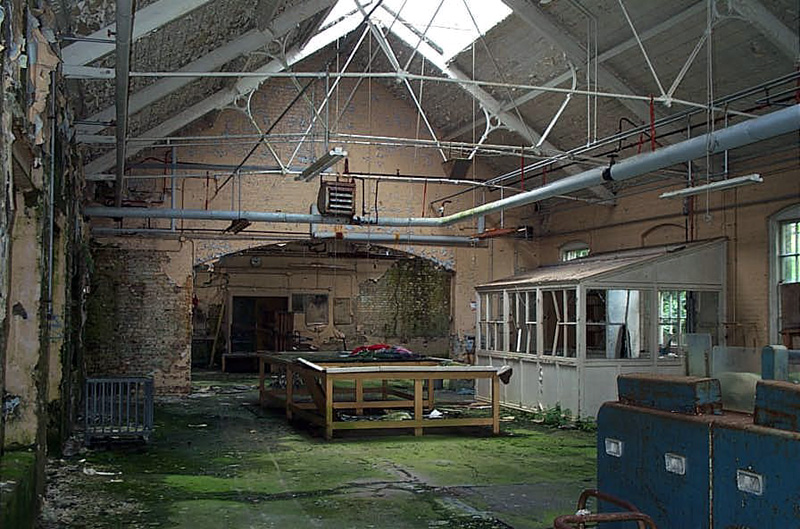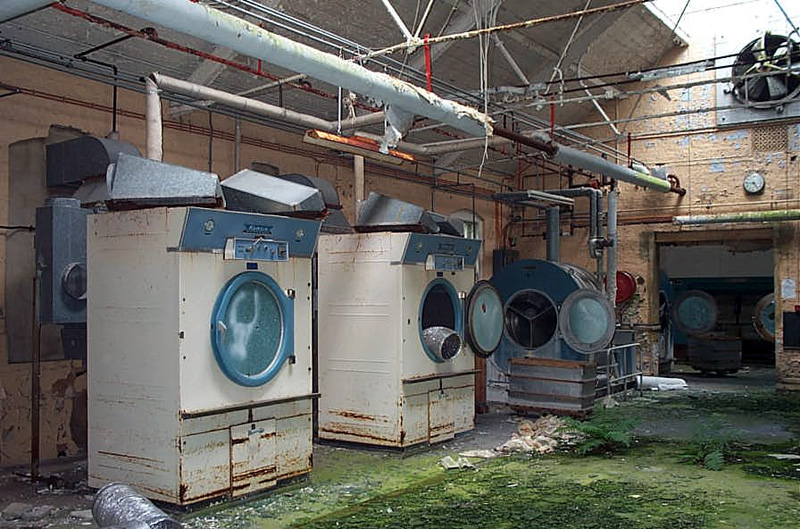|

"Back in 1973 I worked in the laundry at Cane Hill mental hospital for about tweleve weeks. I had just
finished my A levels, so decided to while away the summer months working in the hospital which was only 1 mile
or so from my parents house. Cane Hill often employed students like me but usually as porters. In my case, my grandfather,
who was at that time a tinsmith at the hospital, got me the job. At the beginning of my work there, I felt like cursing him.
I didn't mind the fact that the work was hard, it was the very unpleasant conditions that I found so awful. That's not all,
in the hierachy of hospital workers, the laundry staff were at the bottom. Perhaps this was my grandfather's idea of a bit of fun - he
was known for his practical jokes. Strange as it may seem though, I actually quite enjoyed the job as the weeks
went on. There was a great sense of camaraderie and good humour among the laundry staff." "I now realise that this was a unique experience in all sorts of ways. This era predated much of the
health and safety legislation we have grown up with over recent years. It predated the waiving of hospital Crown Immunity
for Public Health Inspector visits. The laundry itself had equipment in service dating back to the early 20th century. And of
course it predated "care in the community". When I saw the photgraphs on the internet recently taken of the laundry, particularly
the ones that show what I am sure are the very same tumble dryers I operated, I just had to write about it." "I hope readers will find this account of interest, whether from an historical, social or simple curiosity
perspective. I feel in a strange way that I owe it to the memory of those who worked at or were patients in the once
great and terrible institution that, as the photos show, is now the sad, useless and lifeless hollow shell of Cane Hill hospital." "The photos brought back so many memories - the "foul laundry" area (that's what it was called and that's what it dealt with!),
the incinerator where unwanted or misplaced items ended up, the scales for weighing a hundred weight (about 50kg) of dry sheets at
a time prior to washing, the pressing room where several ladies, many of whom were Spanish and Portuguese, ironed and pressed all
day long in the sweltering, steamy heat of those summer weeks." "Something that staggered me when I first set eyes on the laundry was the power transmission system
used for some of the older laundry equipment. Large electric motors drove overhead shafts, from which belts looped
down to the machines' drive systems. These were pre-war, as were the machines they drove. Most, if not all, of the equipment
so driven were simple wash-only machines comprising perforated horizontal cylinders made of thick brass within massive
cast iron outer cylinders measuring 2 or 3 metres in length. The laundry was a living museum with machines of many different
types spanning many decades. It was a noisy and busy place. Motors whirred, steam hissed, belts clacked, water shooshed and people
sweated." "All of work time, including tea breaks, was spent in the laundry building. It was almost an institution within an
institution. Lunchtime was the only time we would venture out into the corridors to make our way to the canteen. It took a while
to get used to these thoroughfares and was somewhat disturbing at first. They were always busy with hospital staff and patients
alike going about their business and were well lit, bright and cheery, not the gloomy passages you might imagine in a Victorian hospital
(they had just been repainted pleasant pastel colours). Some patients spent a lot of their time in these corridors and some would
behave in strange ways. You soon got to predict encounters with such patients as you made your way along. One particular patient
would spin as he walked, how he didn't fall over dizzy I do not know. He would stop passers-by to make a point about something or
other that was on his mind. However, his speech was so rapid no-one could understand him. A smile, a nod, a polite "yes" by way of
response and, satisfied, he would giddily set off again down the corridor to the next person. Other patients were not so extrovert.
I remember one old fellow who paced up and down the same stretch of corridor, day after day. His gaze never moved from the floor
and he would mumble the same disturbed memories to himself, over and over. He was always there when we went to lunch and still
there when we returned. I guess he was there for hours at a time. I wonder what happened to him after hospital closure." "Another patient I clearly remember was a very lucid old lady. She told me that she had been sent to Cane Hill
many years before because she had had an illegitimate child. She said she was quite happy there and recognised that she had bcome
institutionalised, this was where her friends were. Clearly, I cannot vouch for the accuracy of the reason for her being there,
but this sort of terrible treatment did happen to young women in the early part of the twentieth century."
"I remember it said that many years before, the mother of someone famous had been commited to Cane Hill. The problem is,
though, I now have doubts about the story's validity - I had thought it was Charles Dickens mother but, now I know the date the hospital
opened, I cannot imagine that she was still alive at that time. I may have misremembered names: it may instead have been Charlie Chaplin's
mother. Perhaps someone out there can put the record straight, even if it is to confim that the story I heard was simply part of Cane Hill
folklore." "During my work there I never heard of anyone else either famous or connected with fame having been committed to Cane Hill,
apart from one that is. A rumour went round that one of the patients who worked in the laundry was Michael Caine's brother. As you can
imagine, the place was full of all sorts of rumours and gossip. I didn't take this one seriously, but I never forgot it. I was absolutely
stunned when Sir Michael revealed during a recent interview with Michael Parkinson that he did once have a half-brother who had been a patient
at the hospital. However, I cannot verify whether or not he was this person." "The laundry employed a few patients who were able to carry out some of the less demanding tasks. A particular incident
I remember involved a man who operated one of the industry scale spin dryers (not, incidentally, Michael Cane's supposed brother). This
man kept himself to himself and got on quietly with his work. However, one morning on arrival at the laundry, I was alarmed to see a lot
of blood and broken glass on the ground outside. Several laundry windows had been smashed. We soon learnt what had happened. The spin-dryer
man had apparently been barred from the laundry because he had turned up drunk (incredible as it may seem, cider was available to patients
from the hospital shop - this is my recollection, perhaps someone out there can corroborate this). He literally flipped, and the next morning,
before the laundry was open for work, he took out his retribution on the windows, punching them through with his bare hands. He had cut
himself badly and had lost a lot of blood, but he was beyond reason to stop. It was only the restraining action of the fireman, who
heard and investigated the commotion, that prevented further serious harm to himself. We did not see the spin-dryer man for a few weeks
after this. The rumours were rife, but the "word on the street" was that he had been put into a padded cell. I have no evidence that this
was so, but it seemed to be common knowledge that padded cells were still in use. Can anyone else add anything? I'd also like to know
if straight jackets were still in use at that time." "The laundry had more than its fair share of pests. The usual suspects were fleas and cockroaches. On one occasion the ladies
who operated the sheet press were being bitten on their legs so the pest controllers came in to spray their work area. Cockroaches were
common and were to be found, naturally, where there was plentiful food. Deliveries of new kitchen provisions were evidenced by displacd
cockroaches scuttling along the surrounding corridors. I even saw one run over the food servery in the canteen while queueing for lunch.
It did not put me off my lunch (the canteen food was actually rather good). These horrid insects were something you had to get used to when
working in the laundry. We adopted measures to curb their population growth. Socks were separated from other items and put into a large wicker-work basket.
This took about three days to fill. Cockroaches seemed to congregate inside. It would take two of us to get the socks ready for washing, one to
lift the basket and to drop it onto the floor and the other to swill the evicted cockroaches down the drain with lashings of disinfectant. Lovely!" "I operated the tumble driers that can be seen in one of the pictures of the laundry on this website. In 1973 there were five
machines altogether in a row, three of them being rather ancient. Their exhausts, which were virtually at ground level, had been recently modified
to reduce the amount of clothes fibres being put into the atmosphere. A construction made out of angle iron and asbestos sheet(!) had been built
to enclose all five drier outlet ducts in the yard outside. The enclosure was about a metre high, a metre deep and six metres long. The front face
had a wire mesh screen running along its length to catch the fibres. An access hatch was fitted to the side. This was not a good design. The screen
would completely block within half an hour which meant that when I was emptying a machine, the hot air, and it could be very hot, from the other
working machines would find the path of least resistance which was, very unpleasantly, through the open machine and into my face. However, not
to be outdone, I found a neat way to deal with this problem. A nearby fire hose (in fact the one to be seen in the photo of the tumble driers,
the washing machine in front wasn't there then). I would use this to wash the fibres off the screen every half hour. Worked a treat. When
the fireman saw what I was doing, he thought differently. He forbad me from what he described as abusing fire emergency equipment, suggesting
that I crawl through the hatch with a broom and brush the fibres off the screen from the inside (I had already established that a broom would
not work from the outside). This was reminiscent of sending children up chimneys! I informed him that it was physically impossible to do as
he suggested since the stone floor in the enclosure was hot enough to fry eggs on. I continued as before and, to his credit, he turned a blind eye." "Soon after this encounter, the fireman gave instruction to the laundry workers on fire drill and use of equipment. He told
us that the hose, which was the only one in the laundry, covered the whole building. I questioned this, having become very familiar with its workings.
I was certain it was not long enough. We debated this point. Being a somewhat smug and arrogant eighteen year old, I insisted I was right and
that something should be done about it. Exasperated, the fireman asked me to reel out the hose to the far end of the laundry. I happily obliged
and, sure enough, it stopped way short and then someone opened the valve for a bit of a laugh. Well, that proved once and for all that the hose
gave inadequate coverage! The next morning, a brand new pair of fire bukets turned up at the far end of the building." "A most bizzare incident happened one day. The man who worked in the foul laundry section (only one person worked there) emerged
from the filth with a false lower-leg in his hand. He asked the foreman what he should do with it. "Where did you find it?" the foreman asked. "It fell
out of a pair of jeans when I was sorting out the washing". "Hmm", thought the foreman, "chuck it in the incinerator, the owner's probably dead!".
So, up in smoke it went. We never heard anything more; no-one came looking for the leg, so the foremans asessment was probably correct!"
"Death was never far away from the laundry, literally. I passed the mortuary every day on my way to and from work. Usually the
doors were shut, but on occasion they were open, allowing the odd glimpse of the rows of refridgerated storage cabinets. Thankfully, I did not
see any of the those "passing through". What I did see though were the mortuary sheets. The laundry received these as special consignments.
It was all a bit weird really - name tags were often to be found with them. You could always tell the mortuary sheets from the others. They
were the only ones that were both brilliant white and starched." "At one point, the pressure to get washing processed became too great. The place was over-stretched, there were not enough
machines to cope with the backlog. The problem was that an increasingly large pile of nylon bags containing sometimes considerably soiled
washing was mounting. Porters would bring them from the wards and throw them onto the exising pile in the laundry drop-of room. They they
would then be collected by laundry workers on a "last in, first out" basis. This went on for weeks, the backlog building up further and further.
The foreman announced that he wanted staff to work a couple of Saturdays to deal with the situation. This was not a nice task. In order to handle
such festering washing, we filled trolleys with water liberally laced with disinfectant and bleach. The bags were thrown into these to soak for
several hours before being opened." "One of the washing machines was particular fun. It was situated opposite the tumble driers (out of view on the website photos).
This machine was probably mid-60s vintage, stood over two metres tall and had a large horizontal drum, perhaps 1.2 metres in diameter, split
into 3 compartments. A similar arrangement can be seen in in the tumble-drier photo which shows a more modern washing machine with its open door.
Incidentally, there was also one of this type in the laundry at the time I was there. It had a clever hydraulic self-balancing system that kept it
vibration free during the spin-dry phase. These were big machines with large drums and heavy wash loads, many times greater than those of the
domestic versions." "The 60s model in question, however, was not as sophisticated as the later type. It did not have a self-balancing system, but did
sit on rubber mounts to absorb vibration. It was also fitted with a motor cut-out device to prevent excessive motion, the spin dry stage being
the most likely time for such a thing to happen. Now, most people have experienced their domestic machine at some time "walking" across the floor
during spin cycle. That can happen with something like ten pounds (about 5kg) of dry washing which of course weighs several times more when wet.
Imagine what can happen with three hunderweight of dry washing, this being about 150kg, and with a disconnected cut-out! The machine often used
to bounce several centimetres on its mountings and made a fearful racket as it wound itself up to full speed. Everyone would retire to a safe
distance and watch the unfolding drama. There would be a communal sigh of relief once the spin finished. Luckily no serious failure occurred
while I was there, although once the water supply hose flew off under the violent shaking, spraying water everywhere. It made a welcome break
from the usual routine!" "I think I am able to correct Simon with his guess at to what the scales were for in one of the photos. They were used for
weighing a hundreweight at a time of sheets into tall trolleys for loading into each compartment this particular machine. The vibration problems
mentioned above were due to something other than sheets ending up in the washing. All it took to create havoc was a single, rogue jersey which
could absorb much more water than the sheets. As I think back, it seems incredible that a full wash load was three hundredweights. I am sure
that these were the weights used, but I would be very grateful if someone could confirm my memory on this one." "That is about it as far as my laundry memories go. I hope that it might spark other memories and I shall keep track of the
website for further news and stories. Maybe one day someone will write a book on Cane Hill, its history and people. There is a lot to go at." Chris Tombs

|

